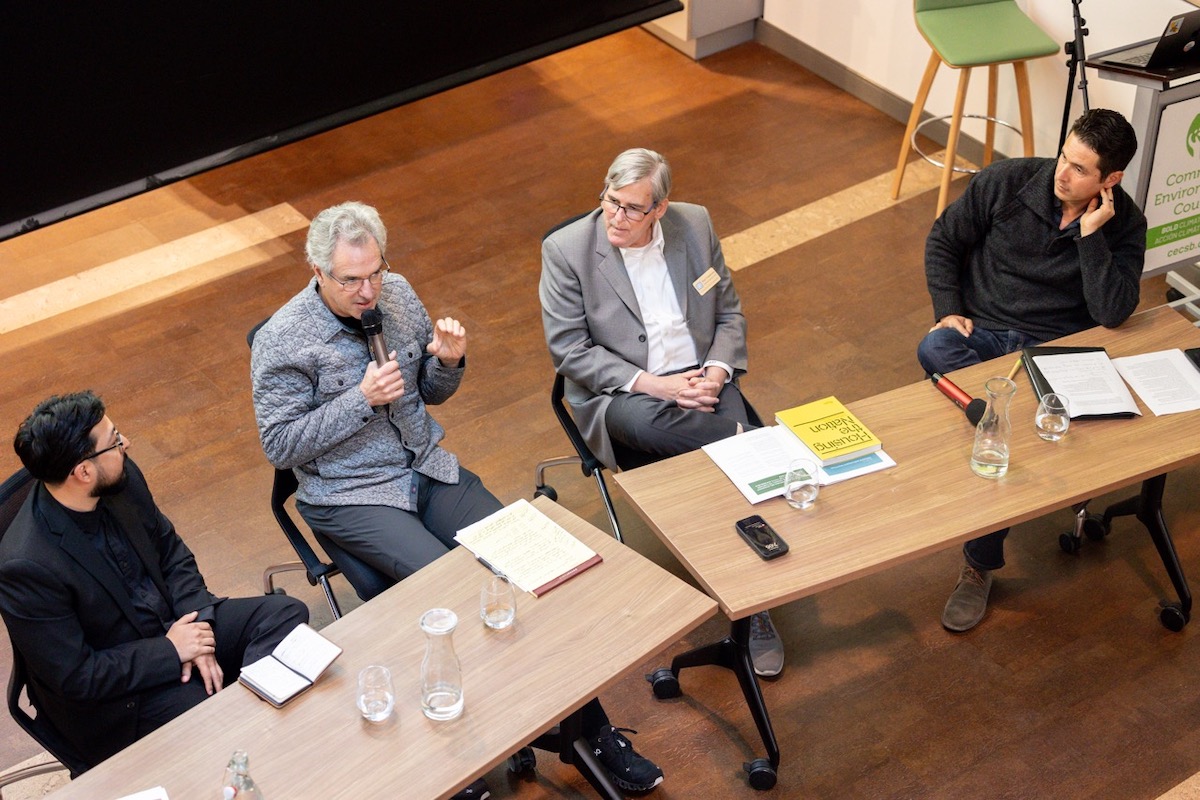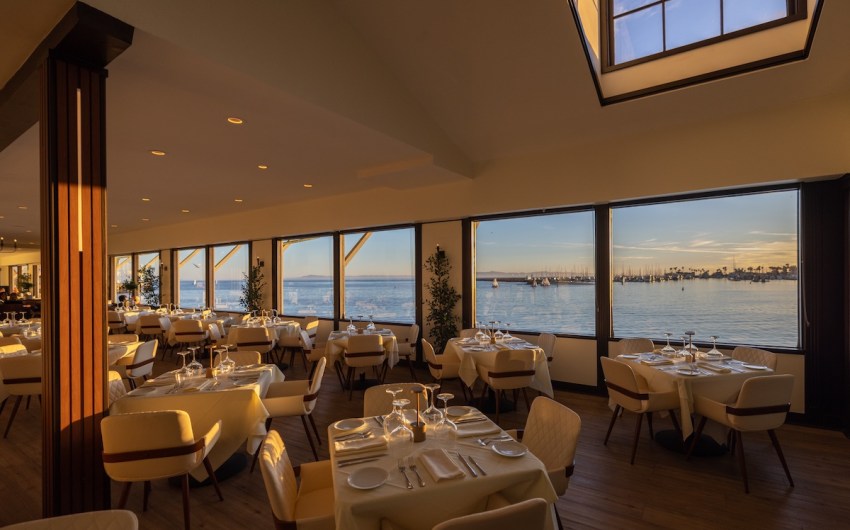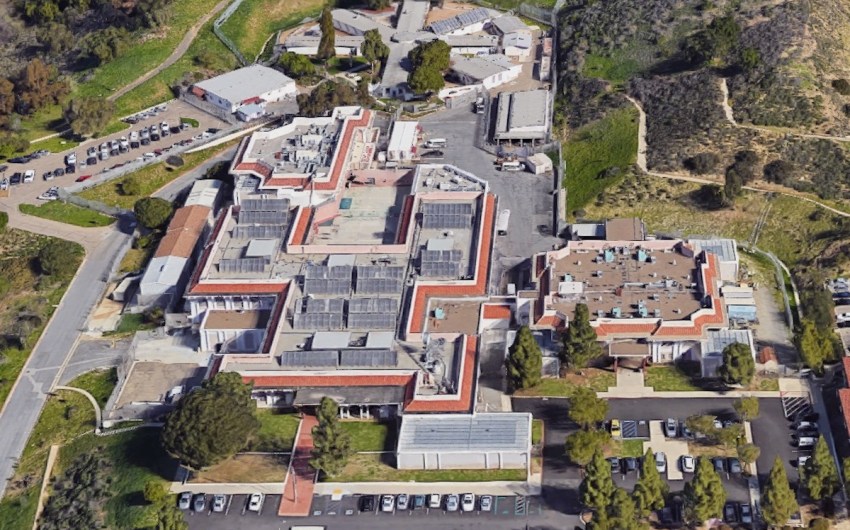Bringing Life to Santa Barbara’s Downtown by Growing Homes
Two Events on Economics and Growth Focus on Housing

Two events on the same topic could not have been more different. The opulent Granada Theatre hosted a $200-a-head gathering for UC Santa Barbara’s Economic Forecast Project, while across the street at the Community Environmental Council, instead of the smell of money, an aspirational vibe lingered in the bare-raftered space housing a free discussion of how to create a livable downtown.
The Economic Forecast opened first at 4:30 p.m. with an introduction by Ed Edick, a Realtor and boardmember of the project, who said they’d opted for a late-afternoon meeting when “everyone could get off from work an hour early” and enjoy drinks afterward. UCSB Chancellor Henry Yang appeared, praising the entrepreneurial engine his university has become, given the high number of patents and companies branching from UCSB.
Economics professor Peter Rupert hosted the annual talk with Gene Deering, a partner in Radius Commercial Real Estate, and Rick Caruso, who bought Montecito’s Miramar Hotel in 2007 and has restored it as part of the Rosewood luxury resorts.
Bringing the Cool Back Downtown
Deering gave the crowd a block-by-block bird’s-eye view of the state of State Steet. Downtown had a 15 percent vacancy rate, he said, but the real number, he suggested, would be higher still given that 10 of the occupied spaces are currently occupied by pop-up stores. The magic word of the afternoon was “adaptive re-use,” and listening to Deering, it was going to take a lot of adaptive re-use to get downtown out of its current listlessness. The good news, he said, was that change was possible: “I know we can get downtown back to being the cool place to be.”
Deering highlighted the 78 units of rental housing now going up on the 400 block behind the old Staples building as an optimistic harbinger of things yet to come. Those units, he said, translated to 300 people living downtown. The whole trick, he said, is to make downtown a desirable destination for locals as well as visitors. And if they actually lived downtown, more than half the battle is already won.


He called downtown’s Macy’s building, abandoned in 2017, a “dinosaur,” meaning that the space could not be made compatible with housing units and would need to be torn down. By contrast, he said, the structure and flow of the former Nordstrom’s department store was more amenable to housing. The great in-between — also known as Paseo Nuevo — he said was key to the future of downtown development. The public, he stressed, needed to temper expectations when it came to affordability. Interest rates had gone up considerably in recent years, as had the cost of building materials and the cost of construction, not to mention the time required to get a project through the city’s design review permitting process.
Ten years ago, he said, downtown commercial development cost $243 a square foot. Today, he said, it’s close to $400. Currently, the unofficial number of housing units being proposed for the Paseo Nuevo site is 500. If 30 to 40 percent of those units are required to be affordable, as some have insisted, “The project is not going to happen,” he said. Should that proposal fall flat, he warned, the site could sit vacant for another 41 years with nothing but pop-up stores.
The Secret of Retail Success
After Rupert’s economic rundown — federal interest rates would be stable or rise, rent control and the minimum wages were bad ideas, Ventura still outpaces Santa Barbara in retail activity — he held a Q&A with Caruso, asking him the secret to his success with retail in Los Angeles.
Caruso’s personality clearly has a lot to do with that success. He spoke ebulliently about his team of designers and architects, who measured distances between storefronts, trees, and lightposts in places like Charleston, South Carolina’s King Street to learn the perfect way to “reduce friction” between the customer and the store.
“At the Grove and at the Americana,” two of Caruso’s malls in downtown Los Angeles and in Glendale, “we want our guests to experience joy. We want more ‘dwell time,’” Caruso said.
Most malls want traffic to move out of parking lots quickly. He does the opposite. He also said he added curbs to create the feel of a real street.
“Our company is in the business of enriching lives, not growing retail or developments,” Caruso said. “For example, at the Grove, we have a trolley that doesn’t go anywhere. It’s for our guests to enjoy, for moms and children to ride and not walk. It’s full every day.”
Caruso’s work to add high-end fashion stores at the Miramar are an example of how he courts the community. “We hold meetings in a place like this,” he said, gesturing to the theater, “and in living rooms, wherever people want to meet. We ask what they like and dislike about a project. We take notes. We listen. We come back and talk again.” Caruso said their outreach had worked so well in Pacific Palisades and at the Grove that no neighbor opposed the environmental impact report for those malls and both passed with a negative declaration.
The worker housing he was adding was a matter of common sense. “You can’t complain about the state and housing if you’re not going to do something about it yourself,” Caruso declared.
Long-vacant spaces on State Street add to its doldrums, Deering had said earlier, showing a slide of the 37 unoccupied spaces between the 500 and 1300 blocks. To get those landlords to budge, rather than a fine or fee — “That’s like taxing someone who’s dying” — Caruso suggested that the mayor, the city council, someone meet with landlords to persuade them to “lean in.” He was sure they would be willing to listen, Caruso said optimistically.
The applause line of the afternoon was Rupert’s statement that the city would find success restoring downtown if the permit process could be guaranteed to be one year. The same point was made across the street at the Community Environmental Council (CEC).
Why Does Permitting Take So Long?
The group of four speakers at the CEC at 6 p.m. included Peter Lewis, who is building apartments at what was once the Staples parking lot on East Gutierrez Street. Real reform is needed in the city building department, said Lewis, who has been a developer in Santa Barbara for several decades. The four-floor, 78-unit building he’s putting up now took four years to get through the city process. When he first went into business, it was two months to a year.
Costs have also increased, though very recently they’ve dipped as supply-chain issues have resolved. His building was costing $400 a square foot, Lewis said, and that’s before the cost of the land. Interest rates for construction loans were around 10 percent, twice the hit of a decade ago.

To get something built, even more important than incentives — like more density or less parking — was to have the barriers removed, Lewis said, something the room agreed on. They also agreed with the goal to increase housing downtown, but to succeed, Lewis again affirmed, the permit time for a conversion of office space to housing or to a mixed use of housing and retail would be burdensome.
“We are making it almost impossible for a housing guy to do it,” Lewis said. “Costs are high to retrofit these buildings. The city needs to get out of the way.”
One of the places where the city was overreaching, in Lewis’s estimation, was in the large ask at Paseo Nuevo for affordable housing. Lewis said that the price tag of $400 a square foot doesn’t change if the unit is affordable or market rate. To make a project even 10 percent affordable meant the other units absorbed the cost of the affordable ones. “Is that fair?” he asked.
Make Downtown ‘Car-Light’
Joining Lewis on the CEC panel were Michael Chiacos, CEC climate policy director; Rob Fredericks, executive director of the Housing Authority of the City of Santa Barbara; our very own Ryan Cruz, Independent news reporter; with Dave Davis of the Metropolitan Transportation District, and wearer of many hats, starting off the talk.
“If you could work anywhere in the world, why not choose Santa Barbara?” asked Davis. He said there was a mismatch of the “local supply, global demand” that affects the city. This affects available dwellings, particularly in the post-pandemic world with many people still working remotely.
Part of Santa Barbara’s great attraction is its environment. To support that, Chiacos argued that a “car-light” downtown would be possible if a higher density of workforce housing were close to jobs. The city’s strict building codes will ensure all-electric properties for new builds, he said, but if downtown workers could live downtown, the city would reduce the carbon produced by vehicles. For the Santa Barbara area as a whole, an estimated 20,000 long-distance commuters drive in from Ventura and North County, mostly due to the shortage of affordable homes locally.
Rob Fredericks, whose Housing Authority of the City of Santa Barbara has found a way to build homes for low-income residents for more than 50 years, stressed that the city must provide funding and incentives to builders to reach those goals. When it came to parking, its El Carrillo and Casa de Las Fuentes apartments each provided one parking spot to each unit and have found only half of the spots are used. Granted, one is for downtown workers and the other for lower-income households, but Fredericks’s point was that cars might not be as necessary for downtown residents.

During the Q&A that followed the panel discussion, Roy Lee, a Carpinteria city councilmember who will become 1st District county supervisor in January, asked whether the city or county should try legally challenging the state’s housing policies such as the builder’s remedy. Ryan Cruz pointed out that other cities have tried to resist the builder’s remedy and been stuck with higher costs and fees. He pointed to Carpinteria’s Accessory Dwelling Unit rules as an example of quick permitting. The two streamlined, “ready to go” plans “are making it so that you don’t have to be a capital-D developer,” Cruz said. “This makes it so that if you want to make a rentable property, it is easier, removing those barriers.”
The one thing both events on Thursday agreed on is that housing would bring life to downtown, which is 5 percent housing and 95 percent commercial. The tussle would be over cars, however. At the Granada, Caruso did not want to be put on the spot and weigh in on the cars versus bikes and pedestrian controversy in Santa Barbara, but he reluctantly said he thought cars on the street would bring some life back. At the CEC, the room agreed that creating a vibrant downtown was aligned with walkability.
Will there ever be a meeting of the minds? Caruso, albeit laughing, said his team could take on the job the city was paying a consultant $800,000 to finalize yet another plan.
Premier Events
Sat, Nov 23
2:00 PM
Santa Barbara
Mosaic Workshop at Art & Soul
Thu, Nov 28
12:00 PM
Santa Barbara
Thanksgiving Dinner at The Harbor Restaurant
Mon, Nov 18
6:00 PM
Santa Barbara
Chaucer’s Book Talk and Signing: Afabwaje Kurian
Mon, Nov 18
7:30 PM
Santa Barbara
Lobero LIVE Presents: Mat Kearney – Headlights Home Tour
Tue, Nov 19
7:00 PM
Santa Barbara
Lecture: “Belonging on an Island – Birds, Extinction, and Evolution in Hawai’i”
Wed, Nov 20
7:30 PM
Santa Barbara
Dr. Uché Blackstock
Thu, Nov 21
5:30 PM
Santa Barbara
Koegel Autism Center Holds Neurodivergent Art Show
Fri, Nov 22
6:00 PM
Santa Barbara
Introduction to Crochet Workshop
Fri, Nov 22
7:30 PM
Carpinteria
Rod Stewart VS. Rolling Stones Tribute Show
Fri, Nov 22
9:00 PM
Santa Barbara
Numbskull Presents: Jakob’s Castle
Sat, Nov 23
7:00 AM
Santa Barbara
Nic & Joe @ Roy
Sat, Nov 23
12:00 PM
Santa Barbara
Fall 2024 Healing Arts Faire
Sat, Nov 23 2:00 PM
Santa Barbara
Mosaic Workshop at Art & Soul
Thu, Nov 28 12:00 PM
Santa Barbara
Thanksgiving Dinner at The Harbor Restaurant
Mon, Nov 18 6:00 PM
Santa Barbara
Chaucer’s Book Talk and Signing: Afabwaje Kurian
Mon, Nov 18 7:30 PM
Santa Barbara
Lobero LIVE Presents: Mat Kearney – Headlights Home Tour
Tue, Nov 19 7:00 PM
Santa Barbara
Lecture: “Belonging on an Island – Birds, Extinction, and Evolution in Hawai’i”
Wed, Nov 20 7:30 PM
Santa Barbara
Dr. Uché Blackstock
Thu, Nov 21 5:30 PM
Santa Barbara
Koegel Autism Center Holds Neurodivergent Art Show
Fri, Nov 22 6:00 PM
Santa Barbara
Introduction to Crochet Workshop
Fri, Nov 22 7:30 PM
Carpinteria
Rod Stewart VS. Rolling Stones Tribute Show
Fri, Nov 22 9:00 PM
Santa Barbara
Numbskull Presents: Jakob’s Castle
Sat, Nov 23 7:00 AM
Santa Barbara
Nic & Joe @ Roy
Sat, Nov 23 12:00 PM
Santa Barbara

























You must be logged in to post a comment.